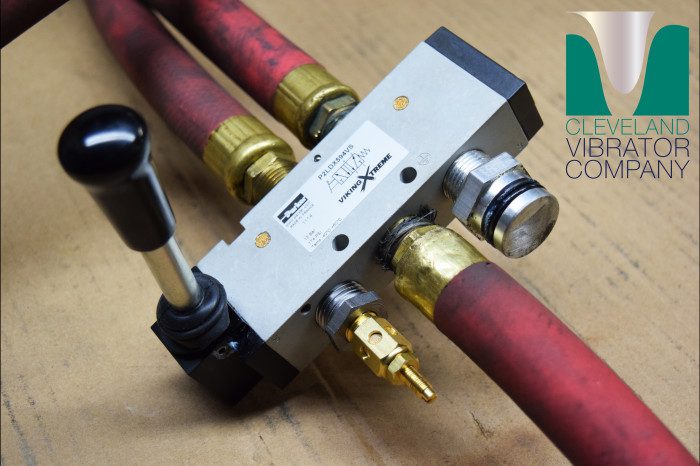There is something to be said about the functionality of a hammer. These tools can be used for a variety of applications, constructive or destructive purposes and are often lightweight components which makes them easy to carry around a shop floor. In this industry, we see and hear them used on day bins, surge bins, bulk storage hoppers, material transfer pipes and other similar equipment to break up bridging or rat-holing product and promote material flow. While this is certainly a quick fix and can help the material flow problems that day, there are a few potential long term issues that can arise when using a dead blow or sledge hammer to break loose the material.
First thing that comes to mind for the Cleveland Vibrator team, and most importantly in our eyes, is the safety of the operator. When using these hammers on bin or hopper, many times the operator is lifting the hammer above shoulder level and swinging up at a bin on a regular basis. This can turn into shoulder problems, back problems or other bodily injuries which everyone should be trying to avoid. Employees and employers alike.
The other potential long term issue is damage to the equipment itself. The OEM’s (original equipment manufacturer’s) of the bins typically do not design the sloped section of bins, load out section of hoppers or flow pipes in anticipation of these pieces of equipment being pounded with a hammer. The stress on the walls can ruin the integrity of the equipment and lead to cracks in the walls or other defects over a period of time.
So to takes steps to prevent these long term issues, we have helped customers with our Single Impact Air Knocker units. When these units are properly sized and installed, which means they are bolted to a piece of channel and then the channel is stitch welded to the hopper, there should be no worries of damage to the equipment. For more about correct installations, please check out this blog. These units have a steel piston on the inside of the casted body that slams down to the impacting position when energized with compressed air. We manufacture sizes ranging from 1-1/4″ diameter piston (approximately 8 lbs total) all the way up to 9″ diameter piston (approximately 700 lbs total). The common units are the 1-1/4″ (model 1125 SI) , the 2″ (1200 SI), the 3″ (1300 SI), the 3.5″ (1350 SI) and the 4″ (1400 SI) diameter piston. In order to best determine which unit would fit the application, we look at the following details:
- Type of material (e.g. soy meal, feed, DDG, coke, plastic pellets or resin, etc.)
- Wall thickness of bin near the discharge outlet or pipe (or where the hammer is currently being used)
- Capacity of sloped section of bin near the discharge (if this is unknown, feel free to provide the dimensions to the Cleveland Vibrator team and they can help with the calculations to determine the approximate capacity of the equipment)
For example, if there is a supply bin with feed ingredients upstream of a mixing tank that is holding 500 lbs of feed in the sloped section and has 1/8″ thick walls, we would suggest the 1125 SI unit.
To control the airflow to and from the Single Impact Air Knockers, we typically use a 5-ported valve. The Cleveland Vibrator company relies on Parker Viking Series valves for consistent operation of the Single Impact Air Knockers. The standard valve we supply comes with a single solenoid head (24VDC or 120VAC) and is a 4-way, 2-position valve. This is used when automating the process is preferred. The solenoid head is either tied into the Cleveland Vibrator Cycle Timer Box (NEMA 4/12 enclosure is standard) or can be controlled with an existing PLC system at the facility.
However, if it is preferred to have a manual setup, we do have 5-ported lever valves available as well. These are 5/2, 2-position lever spring return valves and eliminate the need for the electrical connection. These are great valves to have and allow for quick installation of the Single Impact units. As long as the valve location can be mounted within 10 feet of the Single Impact unit itself, these can replace the hammer swing.
You can see the lever valve in action and some testing we did at the Cleveland Vibrator shop prior to shipping on our YouTube Channel.
Hopefully these tips and the videos can give some insight about how to make your production process easier and more predictable. At the end of the day, the Cleveland Vibrator Company wants to help keep your material moving safely. Whether that is through automated processes or manually operated steps, we want to assist your material handling process. If there are any questions on these components or similar types of applications, please feel free to contact us at any time. We would be glad to talk with you!

Mike joined The Cleveland Vibrator Company team in 2013 with prior experience in manufacturing sales with a Cleveland company in the tool and die industry. Now, he’s the Director of Sales and specializes in “making stuff that shakes stuff”.
When he’s not immersed in the world of industrial vibration, as rare as that might be, Mike keeps busy *not finishing in last place* in Fantasy Football and enjoys spending time with his wife and three kids. It’s always golf season for Mike, and he’s been known to 3 putt his way around any course and can roll tee balls in rain or shine. You can find him tailgating in the Muni Lot before Browns games or supporting local breweries.
As an avid provider of #VibrationEducation, he offers this free bit of advice, “Not all vibration is the same. Force and frequency do matter!” However, there is a 2% upcharge for all Michigan and Steeler’s fans.
Share this blog post:
Follow us:


